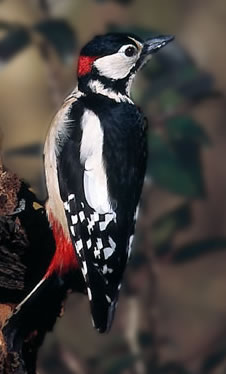Great Spotted and Lesser Spotted

Facts about creatures
- Home
- Animal Classification
- Animal Habitats
- Amphibians
- Arthropods
- Bats
- Birds
- Carnivorans
- Cetaceans
- Chordates
- Crustaceans
- Dinosaurs
- Diprotodonts
- Elephants
- Fish
- Golden Mole
- Insects
- Lagomorphs
- Mammals
- Mammal Teeth
- Marsupial Mole
- Metamorphosis
- Mollusks
- Primates
- Reptiles
- Rodents
- Ruminants
- Soricomorphans
- Tenrec
- Tetrapods
- Vertebrates
Great Spotted and Lesser Spotted
The great spotted woodpecker and lesser spotted woodpecker are notable for the way they persistently drum against wood to attract mates and mark their territory.
Both woodpeckers can be found in Europe and in parts of Asia.
The great spotted woodpecker can be found in deciduous and coniferous forests. It prefers mature trees, usually those that have a few dead or dying branches.

It can often be found in large, old gardens that have big trees.
The feathers of the great spotted woodpecker are piebald with scarlet patches.
Its wings have bold black and white bars. Each wing has a conspicuous white oval patch.
The lesser spotted woodpecker lacks these white patches.
In the great spotted woodpecker, the back is plain black, while in the lesser spotted woodpecker the white bars cross the back.
The underparts of the great spotted woodpecker are white, except for a bright scarlet patch a bright scarlet patch underneath the tail
The male has a small block of scarlet feathers on the nape of his black crown.
The great spotted woodpecker flies by flapping its wings a few times, then making a deep swooping glide. To gain more height, it flaps its wings again.
Woodpecker Adaptations
The tail feathers of woodpeckers have evolved to become extremely strong and inflexible. This allows the tail to serve as a prop – similar to a cane – to help with climbing.
The legs of woodpeckers are short and muscular. Their strong toes have long, sharp claws that allow them to grip onto trees with smooth bark, such as birch.
These adaptations allow woodpeckers to cling to the sides of tree trunks with their heads up.
A woodpecker’s feet are zygodactylous – two toes point forwards and two point backwards. This makes it easy for woodpeckers to move on vertical surfaces.
The great spotted woodpecker’s beak is short, wide and sharp. The end of the beak is squared off, like a chisel.
The woodpecker inserts the tip of its beak into a crack it has made and then uses its powerful muscles to twist the beak and remove flakes of wood.
A layer of shock-absorbing cartilage forms a cushion between the bones within of the beak and the rest of the skull.
Diet
The great spotted woodpecker eats fruits, nuts, seeds, insects and larvae.
It often holds nuts in a cleft in a piece of bark, and then hammers the nuts open as they are held tightly in place.
The great spotted woodpecker locates the larvae that have burrowed inside a tree. It pecks an opening into the tunnel made by the larvae, then uses its long, sharp-tipped tongue to drag them lout.
The woodpecker’s tongue is so long and bulky that it can’t lie in the floor of the bird’s mouth. A thicken tube runs out of the lower jaw, backwards beneath the hidden ears and then up the back of the head to the top of the skull. The tongue is retracted here when it is not in use.
The great spotted woodpecker also eats the nestlings of other birds. It has a cunning way of catching them.
The nestlings of most hole-nesting birds, such as tits, jump up to the entrance of the nest when they see their parent’s shadow.
When a woodpecker’s shadow falls across the hole, a young nestling will jump up to be fed. The woodpecker will then grab it and drag it to a perch, while it will eat it.
Nests
Great spotted woodpeckers excavate build nests in tree trunks or in stout tree branches.
Nests are usually at least 10 feet above the ground, with a circular entrance hole about 2 inches in diameter.
Each clutch usually consists of up to six, spherical white eggs that take about 16 or 17 days to hatch. Both male and female incubate the eggs.
Normally, one brood is produced each summer.
The lesser spotted woodpecker’s nests are usually built on the undersides of dead branches. The nest hole is only about 1 ½ inches wide.
Clutches usually consists of four to six white eggs. Both parents incubate the eggs, and both parents feed the nestlings.
With both woodpeckers, it is about three weeks before the young can fly.
Drumming on Wood
The male advertises for a mate and later marks his territory by drumming on a resonant piece of branch, which is often made of dead wood.
The lesser spotted woodpecker drums at a higher pitch than the great spotted woodpecker. Its drum rolls last two times as long.